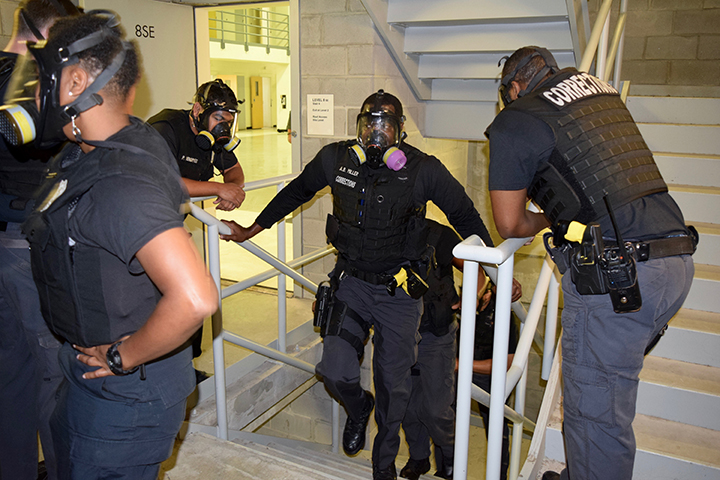The Correctional Tactical Operator in the Midst of a Pandemic
Pandemics are nothing new to us. Over the past 35 years, we have fought through HIV/AIDS, SARS, EBOLA, MERS, Influenza, and now, COVID-19. What is new, however, is how we go about ensuring the safety of those committed to keeping us all safe.
As correctional officers, we are part of our country’s law enforcement machine. We go into this job knowing that, at any time, we could be placed in a position where our lives may be at risk in order to protect the public who we serve. This risk increases when we volunteer to join a tactical team. But that does not mean the administrators should not take all the necessary precautions to ensure the safety and wellbeing of tactical officers.
Many of the pandemic-related protocols and procedures that are currently in place are based on suggestions by the Centers for Disease Control and Prevention (CDC) and the World Health Organization (WHO). While these are undeniably credible resources, their recommendations are intended as general guidelines and must be tailored and adjusted to suit individual settings and circumstances. This is particularly true in the corrections field, where every jail and prison environment is unique and there is no “one-size-fits-all” approach to safety.
Like all things in the tactical world, ensuring good safety practices starts with quality training and proper equipment, followed by well-executed protocols. SWAT teams and other military special operations understand the importance of these factors and have acquired and developed training, equipment and protocols to tackle the specific challenges of COVID-19. Their PPE equipment is the latest and most updated available. In the case of an insurrection, or any critical mission they are called upon to tackle, they recognize that if their operators are exposed to pathogens, it will render a team ineffective and could potentially even cost lives.
In the meantime, many corrections tactical teams are armed with nothing more than paper suits and N-95 masks, leaving them under-protected and highly vulnerable. This lack of proper protection is a major contributor to why there have been so many deaths of correctional officers due to the COVID-19 pandemic.

Most institutions (jails and prisons) will segregate inmates who show any symptoms of coronavirus. But what happens when there are 15 or more inmates who are infected and grouped together in one pod? Add to that a few who refuse to lock down or return to their bunks? Or, what if you have an inmate segregated in a single cell and he decides to harm himself or destroy his cell? Each of these scenarios calls for an officer response – most likely a tactical response. Leadership may choose to activate a CERT team to restore order but, without proper training and equipment, these officers could be walking into a situation where they have a higher-than-usual chance of exposure to COVID-19.

There are many reputable companies out there making effective, high-quality equipment tailored specifically for these types of instances. SWAT teams and military special forces have access to mission-specific equipment. The same should be true for tactical corrections teams. Make no mistake, being activated to conduct a cell extraction or quell a riot in an environment contaminated by coronavirus is a mission where specific tools and tactics are required and warranted. The need for a tactical gas mask with the correct filter, for instance, is key. Similarly, a uniform or suit that provides full protection without the risk of tearing in the middle of a cell extraction or entry into an infected pod is critical. High-performance gloves and head protection are also essential for ensuring officer safety.
In addition to protective outerwear, arming officers with impact or less-lethal munitions allows them to deescalate a situation or isolate the inmates who are causing the incident from a safe distance. Creating a standoff space between the officer(s) and the infected inmate(s) vastly reduces the likelihood of direct exposure.
Equipping officers with all of the aforementioned items, including gas masks, tactical full-body uniforms/suits, gloves, helmets, and less-lethal launchers, is not only the right thing to do to protect the men and women assigned to address these high-risk situations, but it also makes a difference in ensuring that teams stay healthy and able to work. If a team is sent into a contaminated pod without the proper equipment and training and officers end up being exposed to COVID-19, all of those officers now must undergo quarantine protocols. At a minimum, they have to be tested and sent home, causing shift shortages and overtime issues. If officers who are not tactically trained have to be called in to fill staffing gaps, the risk of injuries increases significantly, adding workman’s compensation to the list of potential outcomes. But, most importantly, COVID-19 can cause our valued officers to lose their lives. This is something that should not be tolerated when it can be avoided.
Protecting our officers is not only imperative, it’s smart business. If these practices are not already in place at your facilities, make them an immediate priority. Invest in proper equipment. Commit to tactical training. Follow effective decontamination procedures after responding to incidents. COVID-19 is not to be taken lightly. Your team’s health and that of their families should not be put at risk. Train like your lives depend on it – because the reality is, they do!
As always, you are welcome to reach out to us if you have any questions relating to this subject or anything related to Correctional Tactical Operations.

